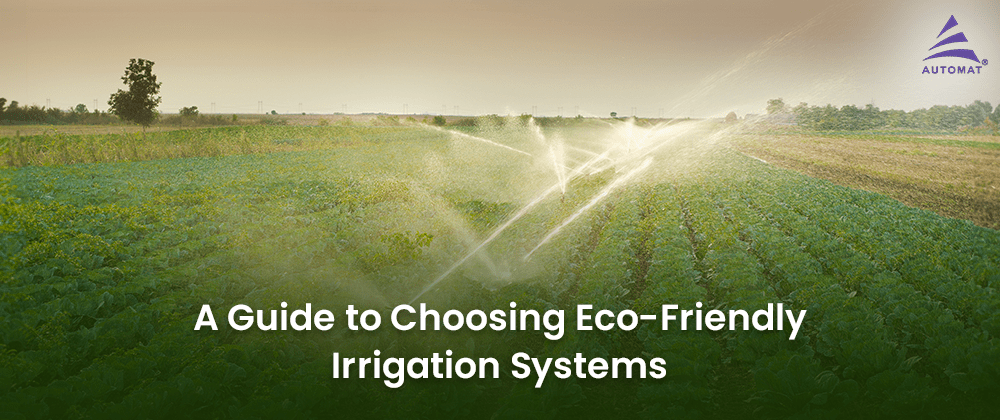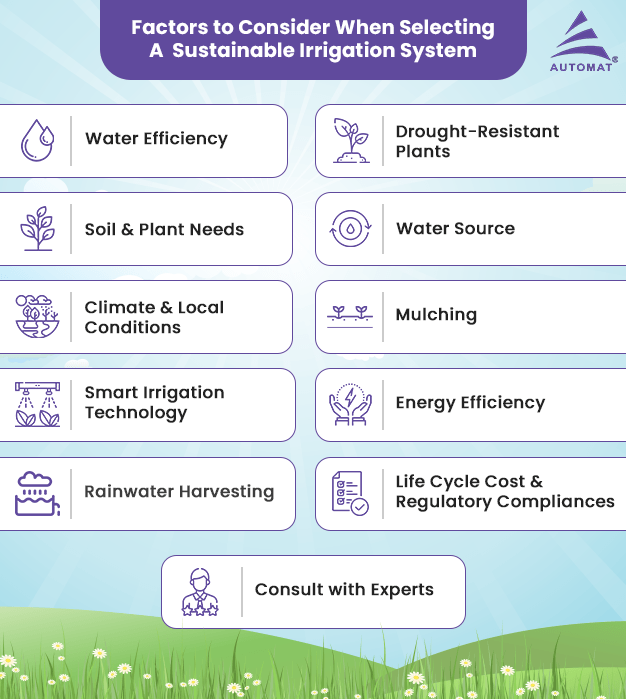
Selecting a sustainable irrigation system involves considering factors like water efficiency, climate, smart technology, and more to promote responsible water usage and environmental conservation. There are certain key factors for selecting water irrigation system that not only meets your needs but also contributes to environmental responsibility.
Factors to Consider When Selecting A Sustainable Irrigation System

Some of the key factors to consider when selecting a sustainable irrigation system are as follows:
1. Water Efficiency
Opt for systems that maximize water efficiency. Drip irrigation such as micro irrigation system, delivers water directly to the roots of plants, minimizing evaporation and runoff while flood irrigation is the most inefficient system and has high water wastage.
2. Soil and Plant Needs
Consider the soil type and the water requirements of your plants. Different systems may be more suitable for specific soil conditions and plant types.
3. Climate and Local Conditions
Take into account the local climate, temperature, and humidity. Some systems may be more effective in certain climates, and adjusting irrigation schedules based on weather conditions can further optimize water use.
4. Smart Irrigation Technology
Invest in smart irrigation systems that use sensors, weather data, and automated controls to adjust watering schedules based on real-time conditions. This can prevent over-watering or loss of moisture due to evaporation.
Read More: Micro Irrigation- The Way to Sustainable Agriculture
5. Rainwater Harvesting
Incorporate rainwater harvesting systems at the farm to collect and store rainwater and also to replenish the ground water. This stored water can be used for irrigation, reducing the dependence on traditional water sources.
6. Drought-Resistant Plants
Consider planting drought-resistant or native plants that require less water.
7. Water Source
Evaluate the source of water for your irrigation system. Whenever possible, use recycled or treated water to reduce the demand on freshwater resources.
8. Mulching
Mulch is a layer of material applied to the surface of the soil around plants and this helps the in retaining soil moisture which helps in reducing the frequency and amount of irrigation needed.
9. Energy Efficiency
Choose irrigation systems that are energy-efficient and can operate from multiple sources of energy. For example, solar-powered pumps and controllers can reduce the environmental impact of the system. According to a research, smart Irrigation systems powered by renewable energy sources have been proven to improve crop yield and the profitability of agriculture.
10. Life Cycle Cost and Regulatory Compliances
Evaluate the overall life cycle cost of the irrigation system, including installation, maintenance, and energy costs. Sometimes, a slightly higher upfront cost may be justified by long-term savings and environmental benefits. Also buy equipment which meets ISI standards as these are usually more durable, and consume lesser water and electricity
11. Consult with Experts
Seek advice from irrigation specialists, landscapers, or agricultural extension services to get insights into the most suitable sustainable irrigation practices for your specific needs. The government has set KVK’s (Kisan Vikas Kendras) across the country to showcase best practises to farmers.
Conclusion
By considering these factors, you can choose a sustainable irrigation system that not only meets your watering needs but also minimizes water waste and environmental impact.
If you have further questions or would like personalized advice on implementing sustainable irrigation practices, feel free to contact us. We’re here to help you make informed decisions for your agricultural needs.




